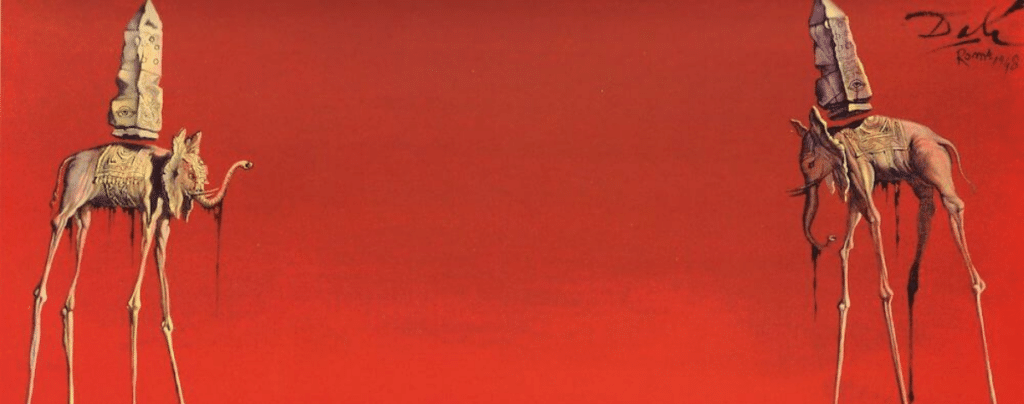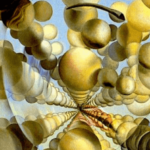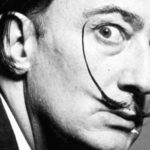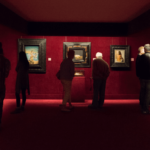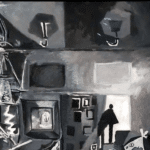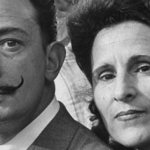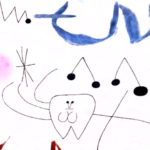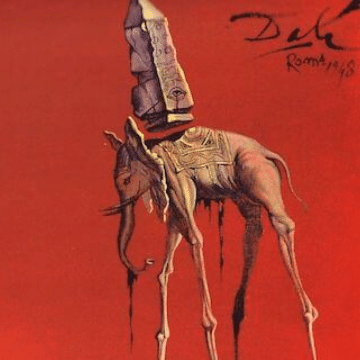
The meaning of Salvador Dali paintings
Discover the symbols that help you understand the Salvador Dali paintings meanings
Salvador Dali was one of the most famous and controversial artists of the Surrealist movement. The surrealists worked with the world of what’s “surreal”, the dream world. Their paintings represent scenes that look real but could never really happen in the real world.
Dali used his own system to achieve this goal – the Paranoiac-Critical Method. According to Wikipedia, Dali described it as a “spontaneous method of irrational knowledge based on the critical and systematic objectivity of the associations and interpretations of delirious phenomena”.
Symbols and icons are nothing else than associations can be interpreted to express a meaning or message that isn’t implied by itself. So it’s not strange that Salvador Dali used them all the time in this paintings. And once you learn to read them, you are equipped to gasp the underlying meaning of his artwork.
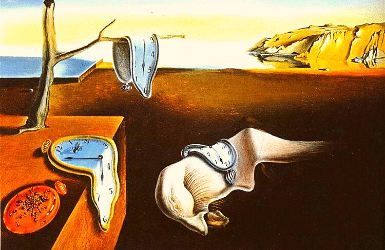
Today we've selected some key symbols used by Salvador Dali that you need to know about to understand the meaning of his paintings. Dive with us into Dali's most intricate lines of thought.
Most important Salvador Dali symbols and their meaning
1
The meaning of Dali's melting clocks
The very first time Dali painted his famous melting clocks was the painting “The Persistence of Memory”. It is said that Dali was waiting for Gala to come back from one of her night outings (with her lovers, probably). It was such a hot evening that the camembert cheese Dali had ordered from room service was melting.
Dali was watching his clock, and Gala was late. And he watched the cheese, and it was melting. And he watched the clock, and he watched the cheese. And then something clicked and he got the idea of the melting clocks. Time was one of Dali obsessions, because the passing of time takes you to death, and he was terrified of death.
He was a second child, born after the death of the first child and named after that dead baby. And even if that was quite common in the early 1900’s, it did traumatize the artist. We could interpret melting clocks as Dali’s shout out to time to be soft with him and not lead him to death.
2
Dali's ants
That’s the sensation ants want to transmit in Dali’s paintings. Because what makes ants terrifying? The fact that they appear to devour dead decayed bodies. Again, the connection with dead is very present here. You’ll also see them in “Soft self-portrait with fried bacon”, where he tells us flesh doesn’t matter.
Dali had a also a lot of sexually-related trauma. It is said that his father showed him at a very young age pictures of bloody and ulcerated male members sick with venereal diseases. The goal was to warn him about the dangers of sex outside of marriage.
But it seems it could have terrified the young Dali so much he became impotent… Hence ants were also used by Dali to express his anguish and fears in front of sexual desire.
3
The meaning of elephants in Dali
So what better icon to symbolize power in Dali’s paintings? Elephants evoke power, strength, dominance… And to reinforce this meaning, Salvador Dali represents them carrying heavy obelisks likely inspired in the Italian Baroque artist Bernini’s works. They sometimes also evoke the idea of the future.
Their surrealist touch is their legs, long and thin like insect legs, that offer an impossible contrast with the elephants heaviness. Some relate these thin, “almost invisible” legs to desire.
You can see elephants decorating the garden of Dali’s Castle Museum in Pubol (Spain), but also in many of his famous paintings: The Elephants, The Temptation of Saint Anthony, Dream Caused by the Flight of a Bee…
4
Dali's crutches
Crutches are devices designed to help you stand and move ahead. And Dali uses them in his paintings to tell us that sometimes fear is so intense he needs help to stay up.
You’ll see them propping up Dali’s face in Soft Self-Portrait with Fried Bacon, in The Sleep (Sommeil) and the Specter of Sex-Appeal, for instance.
5
Eggs as a Dalinian symbol
Mortality and immortality is Dali’s utmost obsession, best depicted in Leda Atomica (Dali Theater Museum, Figueres, Spain). There’s only the shell of a cracked egg there. But the rest of the painting talks about a mythological queen seduced by Jupiter disguised as a swan. Their intercourse resulted in two eggs, with a couple of twin in each.
From each couple, two males and two females, one baby was mortal and the other immortal. Dali identified himself with the immortal male, and his wife and muse Gala withe immortal female. His dead brother and his sister Anna Maria would have been the mortal ones… That tells a lot about Dali’s deepest desires.
6
Salvador Dali's drawers
That’s him wanting to see what’s inside. And once you see what’s inside, there’s light cast over the secrets and there’s no reason to fear them anymore. Except when you discover that inside it’s empty. Again, the void of mortality. The meaningless of fless.
You’ll see his drawers in Anthropomorphic Cabinet, in his sculptures of the Venus of Milo, or in the murals covering the ceiling of the Palace of the Winds in the Theater Museum of Figueres.
7
Bread
To protect himself from the spell, he paints bread that feeds, allowing you to survive. Bread means wealth and life. But it also reminds you of his fear of not having enough, of starving and ultimately dying.
Bread is also intimately related to Christian spirituality, bread representing the body of Jesus. We need to remember that even if Dali lived Christianity in his own non-traditional way, he was born in a Christian society that made part of his personal and artistic background.
Dali uses bread as the hat of the Retrospective Bust of a Woman. And he covers the outside of his Theater Museum with bread buns as an amulet to attract success. But his most fascinating bread is the Basket of Bread that became the symbol of the Marshal Plans for the Recovery of Europe after World War II.
8
Millet's Angelus
There’s references to them in many paintings, but if one piece deserves a special mention is the Angelus by Millet. The original painting depicts a couple of farmers praying in a wheat filed at sunrise.
But Dali sees there references to sex and death: is the man hiding an erection behind his hat? doesn’t the woman’s posture remind of a praying mantis? Female mantises eat off the males head during the copulation… Did Millet first paint the tomb of a dead son between the two characters before deciding to cover it up and change the painting subject?
Millet’s Angelus and praying mantises become a recurring theme in Salvador Dali’s paintings. There’s two paintings dedicated to it: Archaeological Reminiscence of Millet’s Angelus and Architectonic Angelus of Millet. And it appears in several sculptures decorating the Theater Museum in Figueres.
9
Empordà Landscape
Not exactly a Dalinian symbol, but I couldn’t finish this post without make a reference to the landscapes that often appear in the background of Dali’s paintings.
Dali was born in the Emporda County in Catalonia, a plane surrounded by hills and sea. The Mediterranean sea, the mountains near his hometown Figueres and specially the rocky coast of the Cape of Creus in Costa Brava appear as the oneiric background to many of his paintings. Fantastic, but recognizable.
Even some of the rocks near his house in Portlligat seem to have inspired him for the famous The Great Masturbator. They are rocks with organic shapes sculpted by the sea and the wind for ages.
It is not strange that Salvador Dali pays tribute to his homeland. The Emporda is famous for its strong North wind, the Tramuntana. It can blow for weeks non-stop and it is said to make locals lose their mind. Somehow Dali acknowledged that his lunacy and genius came from the local winds…
Are there other Dali symbols give meaning to his paintings?
There’s many more symbols in the world of Salvador Dali. Animals such as lobsters, grasshoppers, snails, lions, giraffes, flies, sea urchins… Flowers and trees such as cypresses, roses, lilies and carnations. Mysterious characters such as angels, ghosts and mannequins. Objects such as keys, telephones, coins or horns.
They all usually revolve around the same themes: death, wealth, fear and sex. Some of them have personal stories behind, some other stem out of art history. I encourage you to make your own research if one of them attracts your attention. Who knows if they’ll reveal some secrets of your own subconscious…
Did you know the meaning of the symbols in Salvador Dali's paintings?
Marta
MORE BARCELONA TIPS FOR YOU:
SHARE WITH YOUR TRAVEL MATES
RESEARCHING FOR A TRIP IS TIME-CONSUMING…
Need more inspiration?
Our 100% FREE Barcelona Collection will give you everything you need to organize the trip of your lifetime to Barcelona.
BEST INSIDER TIPS FROM THE PROS!

Last update on 2024-04-25 / Affiliate links / Images from Amazon Product Advertising API

